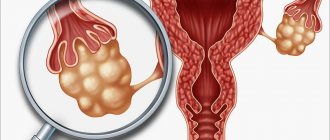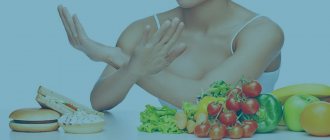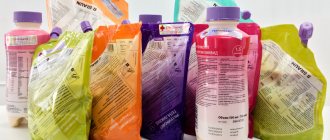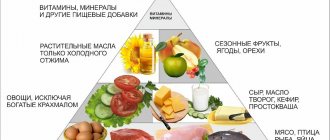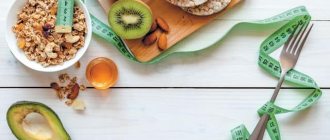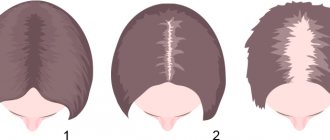Proper nutrition for GERD
The key to solving many problems with the gastrointestinal tract is proper nutrition. Gastroenterologist at the Leninsky Clinic Katerina Chesskaya tells what those who suffer from reflux disease can and should eat.
What is GERD?
Gastroesophageal reflux disease (GERD) is a chronic, relapsing disease in which spontaneous, regularly repeated reflux of stomach contents into the esophagus occurs. As a result, the lower esophagus is affected. The reflux of stomach contents into the esophagus is considered normal if it occurs occasionally and is not accompanied by negative factors. The disease is indicated by frequent recurrence of reflux and inflammatory processes in the gastrointestinal tract.
GERD is usually manifested by belching and heartburn that occurs after eating or bending forward, as well as at night. Pain behind the sternum, radiating to the interscapular region, lower jaw, and left half of the chest, may also indicate the presence of GERD. There are also signs of GERD that are not directly related to the esophagus - cough, shortness of breath, which often occurs in a lying position, hoarseness, dry throat, rapid satiety, bloating. The cause of chronic inflammatory diseases of the nasopharynx (pharyngitis, laryngitis, sinusitis, tonsillitis) in 30% of cases is GERD. It has been proven that against the background of GERD there is a risk of developing obstructive pulmonary diseases, including bronchial asthma.
Proper nutrition for GERD
As with many other diseases of the gastrointestinal tract, the main principle of treatment for GERD is proper nutrition. There are foods that relax the lower esophageal sphincter, which leads to the reflux of acidic stomach contents into the esophagus, that is, reflux. These include; strong tea, coffee, chocolate, citrus fruits, tomatoes, bitters (garlic, onion), freshly brewed mint. As well as fatty fish, meats and products that cause gas formation: baked goods, hot pastries, legumes, brown bread, cakes, pastries, grapes, cucumbers, carbonated drinks. Alcohol and smoking also reduce the tone of the lower esophageal sphincter.
Here is a list of products that you need to consider when creating your menu for the day. Exclude:
1. Bread: fresh rye bread, butter pies and pancakes. 2. Meat: stewed and fried meat dishes from fatty meat and poultry. 3. Fish: fatty fish, fried, smoked, salted dishes. 4. Vegetables: white cabbage, turnips, rutabaga, radish, sorrel, spinach, onions, cucumbers, salted, pickled and pickled vegetables, mushrooms. 5. Fruits: Raw, sour, unripe fruits, dried fruit puree. 6. Cereals: millet, pearl barley, barley and corn cereals, legumes. 7. High acidity dairy products, sharp and salty cheeses. 8. Sweets: halva, chocolate, ice cream, cakes. 9. Drinks: sour, carbonated, fruit drinks, strong tea, coffee and alcohol.
Recommended:
1. Bread: made from first or highest grade wheat flour, yesterday's bread, dry, inconvenient baking. 2. Meat: Beef, veal, chicken, rabbit, turkey, all in the form of cutlets, meatballs, soufflé, puree and quenelles. 3. Fish: boiled river fish - pike perch, pike, perch, any low-fat varieties. 4. Vegetables: carrots, cauliflower, potatoes, beets, pumpkin and zucchini. 5. Fruits: Sweet berries, ripe fruits. Preferably pureed or baked. 6. Cereals: oatmeal, semolina, buckwheat (mashed), rice porridge, in water with milk, boiled vermicelli. 7. Dairy products: milk, lean cheese and low-fat sour cream. Curd dishes made from pureed cottage cheese, for example, cheesecakes, casserole. 8. Sweets: jam, marshmallows, honey, marshmallows, cream and milk puddings. 9. Drinks: weak tea or cocoa with milk, sweet juices and decoctions.
It is also important to adhere to your diet:
— Fractional meals in small volumes and often up to 5-6 times a day. - Do not lie down immediately after eating, the last meal is 2-3 hours before bedtime. — Do not work in a tilted position, avoid the “gardener” pose. — Do not wear tight belts and limit abdominal exercise. — People with obesity need to normalize their body weight.
Remember that only a gastroenterologist can accurately diagnose GERD (as well as any disease). At the appointment, the doctor, together with the patient, will find the cause of the disease, outline a treatment plan and further supportive therapy to avoid relapses.
The Clinic on Leninsky provides receptions for:
- pediatric gastroenterologist Natalya Medvedeva;
- gastroenterologist Ekaterina Chesskaya.
You can make an appointment with a gastroenterologist at the Clinic on Leninsky by phone +7
.
General rules
Gastroesophageal reflux disease is a pathological reflux (reflux) of stomach contents and the appearance of characteristic symptoms and complications.
It is based on motor disorders that lead to dysfunction of antireflux mechanisms. The source of reflux is the “acid pocket” - acid that forms on the surface of the stomach contents 30 minutes after each meal. The volume of the acid pocket is 50-70 ml, which supports constant reflux.
The second cause of castings is a hiatal hernia, the presence of which greatly increases castings. The epithelium of the esophagus is sensitive to the irritating effect of gastric juice, which leads to inflammation of the mucous membrane and the appearance of erosive and ulcerative lesions. Patients experience heartburn , belching of air , a burning sensation behind the sternum, sore throat , and cough. A deterioration in the condition is observed after an error in the diet, and therefore, against the background of the treatment, dietary nutrition is of great importance.
The diet for gastroesophageal reflux disease is aimed at reducing the frequency of reflux and preventing its complications. Patients should avoid eating fatty and fried foods, as well as foods that cause flatulence , as this provokes reflux into the esophagus.
Overeating is completely unacceptable, especially at night, and food should be taken in small portions, but often (5-6 times a day). Drinking alcohol, carbonated drinks, coffee and large amounts of liquid contributes to the occurrence of reflux, so these drinks are excluded, and the water regime is limited to 1 liter per day.
By following these recommendations, patients can prevent reflux into the esophagus:
- avoid overeating and do not lie down immediately after eating;
- avoid working with bending forward, lifting weights, which increases intra-abdominal pressure and increases regurgitation and the frequency of its occurrence;
- avoid constipation and flatulence ;
- dinner should be 4 hours before bedtime;
- using a high pillow;
- taking alkaline mineral waters that reduce acidity, reduce inflammation of the mucous membrane and the frequency of reflux.
The diet for GERD must be followed constantly, otherwise frequent regurgitation of gastric contents can cause complications: erosions , ulcers and stenosis of the esophagus, as well as deeper changes in the esophageal mucosa - Barrett's esophagus , the main manifestation of which is the symptoms of reflux of stomach contents into the esophagus: heartburn, burning sensation behind the sternum, belching, dysphagia and nausea. Increased heartburn is observed with errors in diet (consumption of fried and fatty foods, coffee and carbonated drinks).
The diet for Barrett's esophagus does not differ from that described above, but more strict and long-term adherence to it is required. The same requirement applies to treatment, and for good reason. Barrett's esophagus (or Barrett's metaplasia ) is characterized by the presence of metaplasia (degeneration) of mucosal cells and is a serious complication and can be considered a risk factor for esophageal cancer. Some sources define it as a precancerous condition. Metaplasia in the esophagus can form on a long or short section of the segment.
Diagnosis is based on endoscopic examination and biopsy of a tissue sample of the esophagus. In terms of treatment, patients with this disease, as with severe forms of GERD, must take proton pump inhibitors for a long time. The effect of PPI is based on the suppression of acid production, resulting in a decrease in the volume and damaging effect of the “acid pocket”. All this creates conditions for the disappearance of symptoms and healing of the esophageal mucosa. It is optimal to take these medications 30 minutes before meals.
Gastroesophageal refluxes are often combined with duodenogastric (reflux of the contents of the duodenum into the stomach). The reasons for this may be insufficiency of the pylorus, which does not completely close, chronic duodenitis, or increased pressure in the duodenum. lysolecithin thrown into the stomach in the presence of hydrochloric acid of the stomach have a damaging effect.
duodenogastric reflux manifests itself clinically . Patients develop reflux gastritis (gastritis type C), which is characterized by epigastric pain, belching, bloating, regurgitation of food, heartburn, vomiting bile and coating on the tongue. It is important for diagnosis to carry out daily pH measurements in several parts of the digestive tract: the lower third of the esophagus, the body of the stomach and the cardia of the stomach, which reliably helps to establish the presence of duodenogastric reflux and the degree of its severity. It is believed that duodenogastric reflux is constantly observed in healthy people and it intensifies at night.
It is considered pathological if, during daily pH measurements, an increase in acidity above 5 is observed, which is not associated with food intake. This condition accompanies many diseases of the upper digestive tract ( gastritis , peptic ulcer ), and often develops after removal of the gallbladder.
With gastritis and reflux esophagitis, during the period of exacerbation, when pain intensifies, frequent heartburn appears, nutrition should be as gentle as possible ( Table No. 1A ), and with improvement and in remission, nutrition is organized within Table No. 1 .
This therapeutic diet is moderately gentle, complete, and contains a large amount of fiber with an antacid effect, proteins 100 g, fats 90 g (one third are vegetable), carbohydrates 400 g, salt is limited to 6 g. Calorie content corresponds to 2800 kcal (for humans not engaged in physical labor).
- Strong secretion agents are excluded.
- Products containing connective tissue (cartilage, skin, stringy meat).
- Reduce fiber-rich vegetables (turnips, radishes, asparagus, legumes), bread with bran, fruits with rough skin (grapes, gooseberries, dates, currants).
- Food is steamed, mushy and mostly pureed. Baking without a rough crust is allowed.
- Fractional meals are organized in small portions.
- Most of the calories should come in the first half of the day, and dinner should be light.
Diet according to Pevzner
When diagnosing GERD, the patient is assigned to table No. 1. It is necessary to observe it during the period of exacerbation or during the initial detection of the disease. Duration – 1 week. The menu includes gentle dishes that can have minimal impact on the inflamed esophageal mucosa. This promotes accelerated healing and scarring of the resulting ulcers.
Allowed foods can be boiled or steamed. Dishes are served pureed or liquid. Serving hot or cold is prohibited: food must be warm. The patient is served steamed omelettes, jelly, soups, and various cereals. Meals for GERD are divided - every 3 hours in small portions. The diet for GERD with esophagitis and high acidity of gastric juice has some differences.
If the disease is complicated by the development of esophagitis, then the patient’s food is served exclusively pureed. This solves the typical problem of dysphagia for this form of the disease (pain when swallowing, food getting stuck in the throat). For breakfast, it is recommended to serve porridge and warm teas; kefir is ideal for an afternoon snack. For lunch - puree soup. Boiled vegetables can be garnished with mashed potatoes, first crushed using a blender.
With a combined course of GERD and gastritis, in which acidity is increased, a gentle diet is necessary. Sweets, spices, fatty/spicy foods, and carbonated drinks are strictly prohibited. The menu must be agreed with the attending physician.
Advice! For severe heartburn, the menu should include rice, baked apples, and jelly.
During the period of exacerbation of GERD, in addition to taking medications, it is necessary to follow a strict diet. The patient is allowed porridge cooked in water and other boiled dishes. You need to follow it for one to two weeks, until your overall well-being improves.
Sample daily menu:
Diet for reflux esophagitis + menu
- breakfast - porridge and rosehip decoction;
- second breakfast - cottage cheese;
- lunch - soup, boiled breast with a side dish of boiled vegetables;
- afternoon snack - vegetable salad of boiled beets with carrots, seasoned with vegetable oil;
- dinner - vegetable stew or cottage cheese casserole.
During the period of remission of the disease, the list of permitted products can be slightly expanded. For example, a patient can eat sweets, but in limited quantities. Fatty dishes and foods are still prohibited.
Sample menu for the day:
- breakfast – cottage cheese with sour cream, tea, dry biscuits;
- second breakfast - sweet berry jelly;
- lunch - soup with low-fat broth, boiled meat with side dish;
- afternoon snack – sweet juice with biscuits;
- dinner - steamed cutlets, garnished with vegetable stew.
[node:field_field_doprekl2]
Prevention of exacerbation of GERD consists of following the basic principles of dietary nutrition. For breakfast, you should serve porridge, adding raisins to it for variety and improved taste. Second breakfast - biscuits and permitted drinks. Cereal soups, lean meats, and vegetable salads are good for lunch. Afternoon snack – a decoction of rose hips and jelly. You can take fish to prepare dishes for dinner.
Sample menu for a week for GERD
The list of products that are planned to be used when drawing up the menu must be agreed upon with the attending physician and nutritionist. Sample daily menu for the classic course of gastroesophageal reflux disease:
- breakfast - pumpkin pudding with potatoes, topped with sour cream sauce, a little steam omelet, herbal infusion, biscuits;
- second breakfast - vinaigrette, a piece of yesterday's bread made from wheat flour, low-fat yogurt, jelly;
- lunch – noodle soup and vegetables, rice porridge, chicken baked in foil, sweet tea;
- afternoon snack - cottage cheese casserole, permitted drink;
- dinner - boiled fish with vegetable salad, a piece of stale white bread, compote;
- before bed – jelly.
What is GERD
Reflux is the reflux of stomach contents into the esophagus, which causes damage to its mucous membrane. In fact, with every episode of reflux, the delicate lining of the esophagus gets burned and the person experiences heartburn.
This happens either due to excess production of hydrochloric acid, or due to impaired motility of the gastrointestinal tract, when food does not leave the stomach for a long time.
Sometimes heartburn that occurs is considered a variant of the norm, because we all periodically make mistakes in nutrition. But if this is repeated often, then, unfortunately, the lower part of the esophagus suffers, the mucous membrane of which is not protected from the aggressive effects of gastric juice.
In addition, it is believed that about a third of all inflammatory diseases of the upper respiratory tract (eg, tonsillitis, pharyngitis, laryngitis) are associated with GERD. It has already been proven that the reflux of stomach contents into the esophagus and higher can provoke obstructive bronchitis and even the development of bronchial asthma.
Symptoms of GERD
GERD is quite difficult to diagnose because it has many manifestations and forms.
Symptoms of gastroesophageal reflux disease are usually divided into gastroenterological (related to the gastrointestinal tract):
- Heartburn
- Belching
- Bad taste in the mouth
- Bloating
- Feeling of heaviness in the stomach after eating;
And extraesophageal (at first glance not related to the esophagus), namely:
- Pain behind the sternum, which can be confused with pain in the heart
- Tachycardia (rapid heartbeat)
- Arrhythmia
- Dyspnea
- Stomatitis
- Erosion of tooth enamel, caries
- Hoarseness of voice
- Feeling of a lump in the throat
- Dry mouth
- Prolonged runny nose
- Chronic cough
- Bronchospasm
Guiding Principles of Nutrition
To prevent exacerbation and improve the patient’s current condition, doctors recommend strictly adhering to basic nutritional rules. These include the following recommendations. The dishes served to a person should be varied, and the nutrition should be balanced, that is, provide the body with all the necessary vitamins, minerals and microelements.
Small meals are recommended - at least 5-6 times a day. The patient should not overeat. To do this, you not only need to reduce portions, but also serve food on a smaller plate. Visually, the portion will look larger than it actually is. It is necessary to limit the consumption of salt and seasonings as much as possible.
It is advisable to completely remove spicy, fried, salty, and smoked foods from your diet. They have a bad effect on the inflamed mucous membrane of the esophagus, intensifying the current symptoms. Fresh onions, garlic, hot peppers and any spices are completely excluded from the menu. The last meal should take place at least 2-3 hours before going to bed.
Snacks on the run and dry meals are strictly prohibited. Food must be chewed thoroughly, well moistened with saliva. After eating, any physical activity or exercise is completely prohibited. You can do household chores after at least 1 hour. This will prevent the development of reflux (reflux). After eating, it is advisable to take a short walk.
Important! With this pathology, patients are prohibited from taking fasting days. This can cause increased pain and the development of heartburn.
No ads 1
Authorized Products
- Soups with vegetable broth (in this case, cereals and vegetables need to be pureed). Ready-made soups are seasoned with egg flakes or butter. Sautéing vegetables for dressing is not allowed.
- Dried wheat bread.
- Beef, lamb, lean pork, turkey and chicken are served boiled and rolled (cutlets, souffle, quenelles). Baking with milk and sour cream sauce is allowed.
- Steamed dishes from lean fish (they can be eaten in pieces or in the form of cutlets).
- More benign cereals that do not contain a lot of fiber are allowed: semolina, buckwheat or rice. They can be boiled in water or with the addition of milk. Buckwheat and rice porridge are pureed and diluted with water (milk) to a semi-viscous consistency.
- Milk, cream and non-sour kefir, milk jelly and milk cream are allowed. Medium fat cottage cheese in the form of soufflé and pudding. It is worth excluding highly acidic fermented milk products.
- Vegetables should be chosen with low fiber content (potatoes, cauliflower, beets, pumpkin, carrots). They are steamed and prepared into purees or vegetable puddings.
- Butter (20 g) and sunflower oil (refined) are added to ready-made dishes, excluding heat treatment.
- Sweet fruits are used to prepare purees, jelly, jellies, and compotes. Eating raw fruits is not allowed.
- Drinks include weak tea with milk and sweet juices. You can add sugar or honey to drinks.
Table of permitted products
| Proteins, g | Fats, g | Carbohydrates, g | Calories, kcal | |
Vegetables and greens | ||||
| zucchini | 0,6 | 0,3 | 4,6 | 24 |
| cauliflower | 2,5 | 0,3 | 5,4 | 30 |
| potato | 2,0 | 0,4 | 18,1 | 80 |
| carrot | 1,3 | 0,1 | 6,9 | 32 |
| beet | 1,5 | 0,1 | 8,8 | 40 |
| pumpkin | 1,3 | 0,3 | 7,7 | 28 |
Cereals and porridges | ||||
| buckwheat (kernel) | 12,6 | 3,3 | 62,1 | 313 |
| semolina | 10,3 | 1,0 | 73,3 | 328 |
| cereals | 11,9 | 7,2 | 69,3 | 366 |
| white rice | 6,7 | 0,7 | 78,9 | 344 |
Bakery products | ||||
| wheat bread | 8,1 | 1,0 | 48,8 | 242 |
Confectionery | ||||
| jelly | 2,7 | 0,0 | 17,9 | 79 |
Raw materials and seasonings | ||||
| honey | 0,8 | 0,0 | 81,5 | 329 |
| sugar | 0,0 | 0,0 | 99,7 | 398 |
| milk sauce | 2,0 | 7,1 | 5,2 | 84 |
| sour cream sauce | 1,9 | 5,7 | 5,2 | 78 |
Dairy | ||||
| milk | 3,2 | 3,6 | 4,8 | 64 |
| cream | 2,8 | 20,0 | 3,7 | 205 |
Cheeses and cottage cheese | ||||
| cottage cheese | 17,2 | 5,0 | 1,8 | 121 |
Meat products | ||||
| boiled beef | 25,8 | 16,8 | 0,0 | 254 |
| boiled veal | 30,7 | 0,9 | 0,0 | 131 |
| rabbit | 21,0 | 8,0 | 0,0 | 156 |
Bird | ||||
| boiled chicken | 25,2 | 7,4 | 0,0 | 170 |
| turkey | 19,2 | 0,7 | 0,0 | 84 |
Eggs | ||||
| chicken eggs | 12,7 | 10,9 | 0,7 | 157 |
Oils and fats | ||||
| butter | 0,5 | 82,5 | 0,8 | 748 |
Non-alcoholic drinks | ||||
| mineral water | 0,0 | 0,0 | 0,0 | — |
Juices and compotes | ||||
| juice | 0,3 | 0,1 | 9,2 | 40 |
| jelly | 0,2 | 0,0 | 16,7 | 68 |
| rose hip juice | 0,1 | 0,0 | 17,6 | 70 |
| * data is per 100 g of product | ||||
